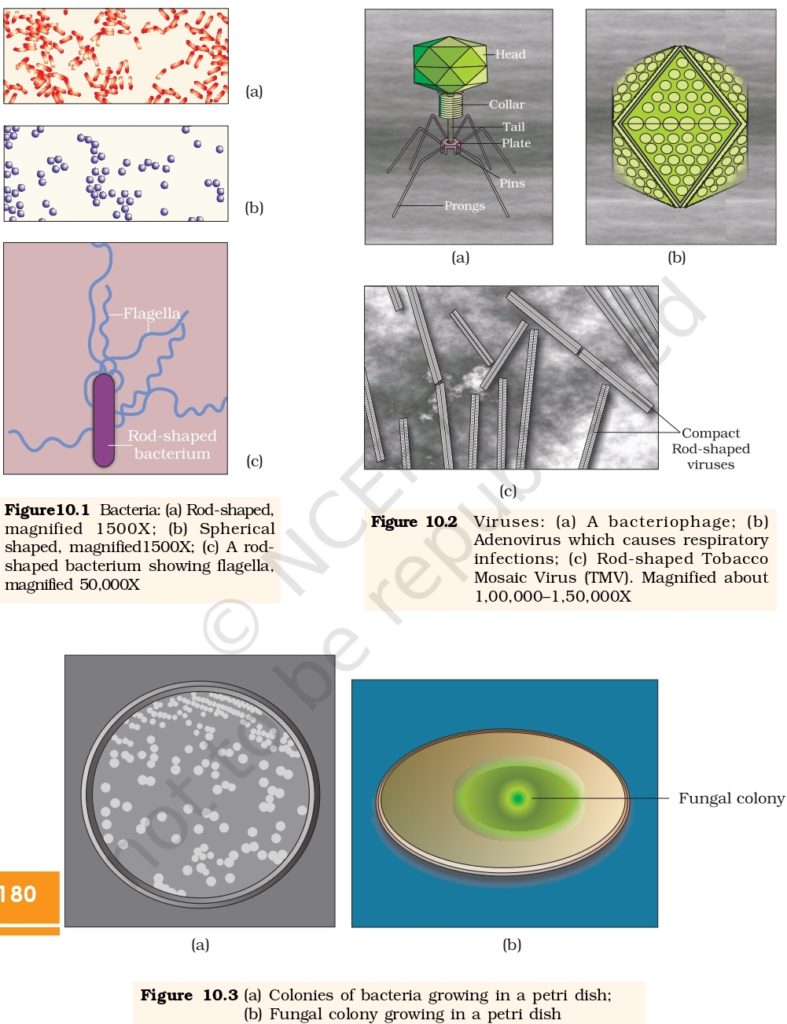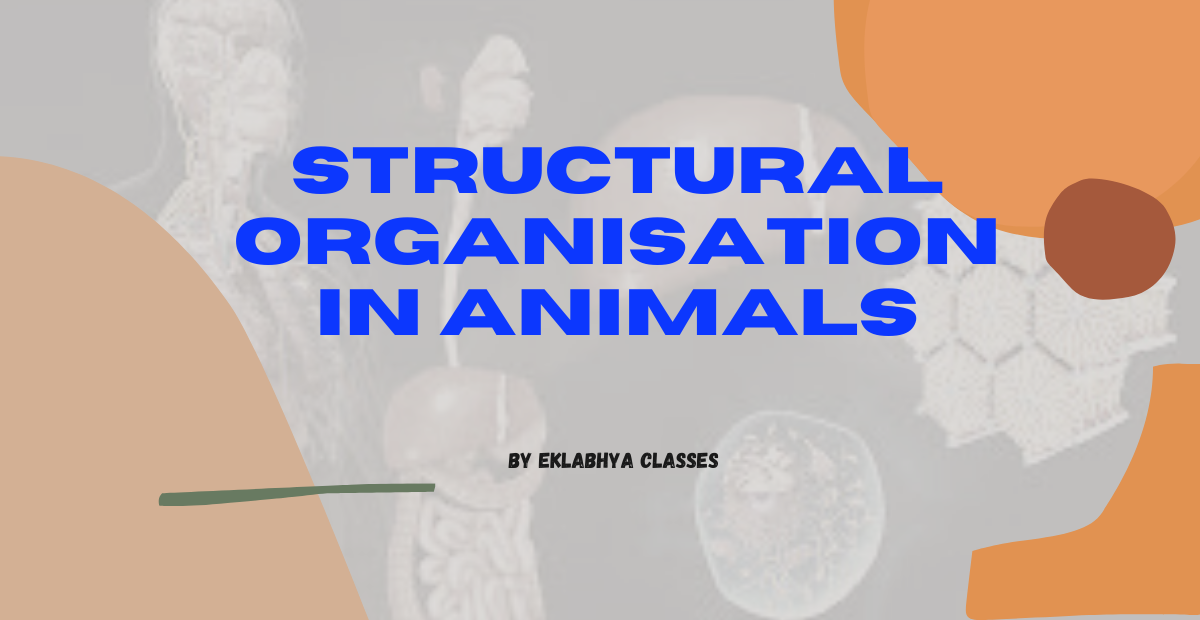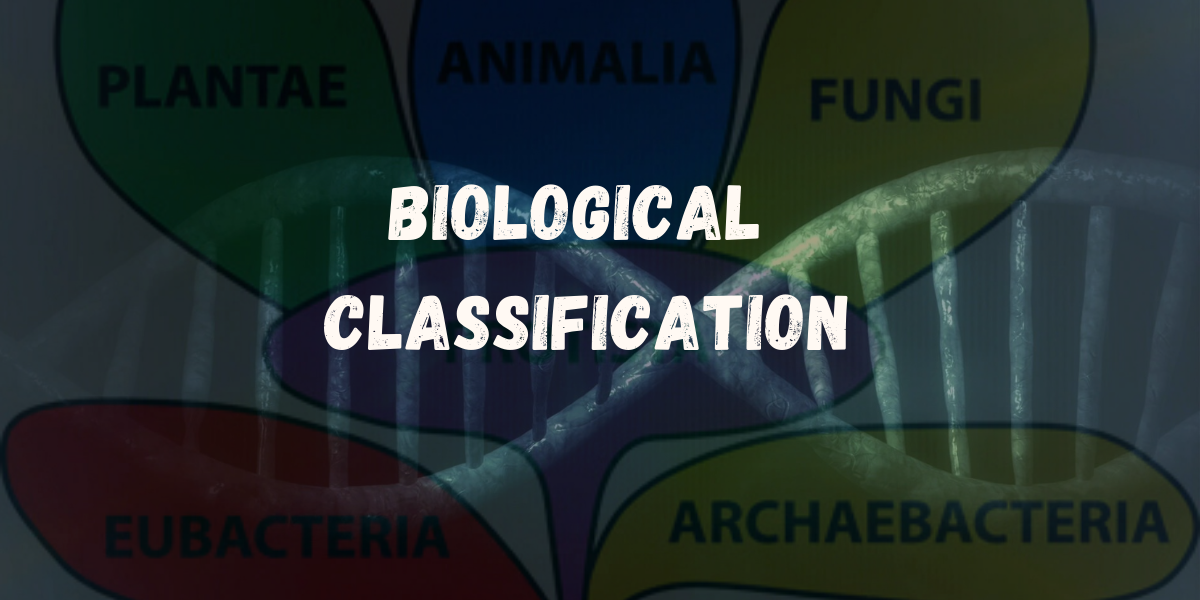- Microbes are present everywhere- soil, water, air, inside our body .
- Microbes are diverse - Protozoa, bacteria, fungi and microscopic plants viruses, viroidsand also prions that are proteinacious infectious agents.
- Microbes like bacteria and many fungi can be grown on nutritive media to form colonies which are useful for studies.
- They also cause disease in plants and animals.
- All Microbes are not harmful.

Microbes in Household Products
- (Lactobacillus) Lactic acid bacteria (LAB) produce curd from milk. (NEET 2019)
- LAB produces acids that coagulate and partially digest milk proteins.
- Small amount of curd that is added to the milk for curdling acts as an inoculum containing thousands of LABS, which further multiply.
- LAB enhances the nutritional value of milk by increasing Vitamin B¹². (NEET 2018)
- LAB present in stomach prevents infections.
Fermentation
- Dosa and idli dough is fermented by bacteria, which produces carbon dioxide gas and gives it a puffed-up appearance.
- Dough used for making breads is fermented by baker’s yeast (Saccharomyces cerevisiae).
- Yeast are belong from fungi (eukaryotes) (NEET 2018)
- ‘Toddy’ (a traditional drink from South India made by fermenting sap from palm trees)
- Microbes are also used to ferment fish, soyabean and bamboo- shoots to make foods.
Cheese making
- The bacterium Propionibacterium sharmanii is used in ‘Swiss cheese’ to give it its characteristic holes by producing large amount of carbon dioxide.
- ‘Roquefort cheese’ is ripened by growing certain fungi on them to give them their specific flavour.
Microbes in Industrial Products

- For industrial purposes, microbes are grown in large vessels called fermentors.
- On industrial scale, fermented beverages, antibiotics, enzymes, and other bioactive molecules are prepared using microbes.
Fermented beverages
- Saccharomyces cerevisiae, also called brewer’s yeast, is used to prepare ethanol. (NEET 2017)
- wine and beer are produced without distillation.
- whisky, brandy, rum are produced by distillation of the fermented broth.
Antibiotics
- Certain microorganisms inhibit the growth of other microorganisms wherever they grow.
- Antibiotics are chemical substances produced by certain microbes that kill or retard the growth of other microbes (disease-causing microbes).
- Penicillin discovered by Alexander Fleming was the first antibiotic to be discovered.
- Fleming discovered it by chance when he was working on the bacterium Staphylococcus. He discovered that growth of Staphylococcus ceases in the culture plates where Penicillium notatum was grown.
- Later on, its use as an effective antibiotic was established by Ernest Chain and Howard Florey.
- Fleming, Chain and Florey were awarded Nobel prize in 1945 for this discovery .
- antibiotics have greatly improved over capacity to treat deadly diseases such as plague, whooping cough (kali khansi) , diphtheria (gal ghotu) and leprosy (kusht rog).
Chemicals, enzymes and other bioactive Molecules
Acid Producers are (NEET 2015-16-17-19)
- Aspergillus niger (fungus) - citric acid
- Acetobacter aceti( Bacteria) - acetic acid
- Clostridium butylicum (Bacteria) - butyric acid
- Lactobacillus (Bacteria) - Lactic acid
- Lipases Enzymes are used in detergent formulations and are helpful in removing oily stains from laundry.
- Bottled juice are clarified by the use of pectinases and proteases enzyme.
- Streptokinase produced by bacteria streptococcus are modified by genetic engineering and use as a clot buster for removing clots from blood vessels of patients with myocardial infarction leading to heart attack.
- Fungus Trichoderma polysporum use to produce bioactive molecule Cyclosporin A (used as immune-suppressive agent in organ transplantation)
- Yeast (Monascuspurpureus) use to produce Statins have been commercialized as lower blood cholesterol levels. (NEET 2016,19)
Microbes in Sewage Treatment

- Sewage basically consists of human excreta. It contain large amount of organic matter and microbes( microbesmay be pathogenic also).
- Sewage disposal is a huge problem. It cannot be directly
- Disposed into rivers and streams. Hence, it has to be treated first in sewage treatment plants (STPs).
- The heterotrophic microbes present in the sewage itself aid in its treatment.
Treatment of sewage includes two stages − Primary treatment and Secondary treatment.
• Primary Treatment − Involves physical removal of particles by filtration and sedimentation
- Initially, sequential filtration is used to remove floating debris.
- Then, grit (soil + small pebbles) are removed by sedimentation. Solids that settle down form the sludge while the supernatant forms the effluent. (NEET 2017)
- Effluent is taken for secondary treatment.
• Secondary Treatment

Effluent is passed to aeration tank → Constant agitation → Air pumped → Vigorous growth of bacteria → Floc formation → Consumption of organic matter by bacteria → Decrease in BOD
- BOD is the amount of oxygen required by bacteria to oxidise all the organic matter(petroleum compounds are not organic) present in the effluent. (NEET 2016)
- Naturally, if organic matter decreases → BOD decreases →Pollution decreases
• What is a floc?
- Floc = Bacteria + Fungal filaments (in a mesh-like structure)
- When BOD and hence pollution is reduced, effluent is passed into a settling tank. Here, flocs settle down and it is known as Activated Sludge.
- In anaerobic sludge digesters, anaerobic bacteria act on the activated sludge to produce biogas (methane, carbon dioxide and hydrogen sulfide). (NEET 2013-14)
- The effluent from secondary treatment plant is released into water bodies.
- Microbial technology for sewage treatment is so effective that no human technology has been able to beat it till date.
- The ministry of Environmental and forests has initiated Ganga Action Plan and Yamuna Action Plan.
Microbes in Production of Biogas

- Microbes produce many gases during their metabolism.
- The type of gas produced depends upon the substrate they grow on and the type of microbe.
- Anaerobic bacteria usually produce methane along with carbon dioxide and Hydrogen. Such bacteria are calledmethanogens.Example - Methanobacterium
- Methanogens are commonly found in anaerobic sludge (as in sewage treatment) and in the rumen of cattle. In the rumen of cattle, these bacteria help in cellulose digestion.
- Hence, excreta of cattle (gobar) are rich in methanogens. Biogas is also called gobar gas.
Biogas Plant − Components of biogas plant:
- Concrete tank− Here, slurry of dung is fed. It is a 10 − 15 feet deep tank.
- Floating cover− Placed on slurry; rises as the gas is produced utlet − It is connected to the pipe.
- Pipe − It supplies the biogas to nearby houses.
- Outlet for spent slurry − Spent slurry can be used as a fertiliser.
- Biogas plant is usually set up in rural areas since cow dung is available in abundance there.
- Biogas is used for cooking and lighting.
- Biogas technology in India is due to the efforts of:
- IARI (Indian Agricultural Research Institute)
- KVCI (Khadi and Village Industries Commission)
Microbes as Biocontrol Agents
Chemical insecticides and pesticides are harmful as:
- They kill the useful and harmful life forms indiscriminately.
- They are toxic to human beings as well as in the long run.
- our soil is Also polluted through our use of weedicides to remove weeds.
Biological control of pests and disease
- If all insects of a particular species are killed, then the natural predator-prey relationship and food chains will get distorted.
- Hence, biological means to eradicate pests can be used. This requires knowledge of the life forms (predator + prey) that inhabit a particular area, their life cycles, and patterns of feeding and preferred habitats.
Example − Ladybirds and dragonflies are used to get rid of aphids and mosquitoes.
- Microbes can also act in the same manner. Bacillus thuringiensis (Bt) is used to control butterfly caterpillars.
- This bacterium is available in sachets as dried spores, which are sprayed on the crops. The spores get into the gut of the larvae and kill it while the other insects remain unperturbed.
- By methods of genetic engineering, the genes of B. thuringiensis responsible for killing the larvae have been incorporated into the plants.
- Cotton plant with Bt gene incorporated is called Bt-cotton.
- The fungus Trichoderma living in roots of plants acts as a bio control agent against several plant pathogens.
- Baculoviruses, particularly genus Nucleopolyhedrovirus,are also used as narrow spectrum insecticidal agents. (NEET 2019- 2 Qu)
Bio control agents are particularly useful when useful insects are required to be conserved under IPM (integrated pest management programmes).
Microbes as bio-fertilizers
- Bio-fertilizers are organisms that enrich the nutrient quality of the soil.
Many bacteria, fungi, and cyanobacteria act as biofertilizers.
• Bacteria-
- They act as bio-fertilizers by living in symbiotic association with root nodules of leguminous plants such as Rhizobuim.
- These bacteria fix atmospheric nitrogen and enrich the nitrogen content of soil.
- Free Living bacteria Azospirillum and Azotobacter also fix atmospheric nitrogen.
• Fungi
- Fungi also form symbiotic associations with plants (Mycorrhiza) such as Glomus. They absorb phosphorus and pass it to plants. (NEET 2012,15)
- Plants having such association show other benefits also, such as resistance to root-borne pathogens, tolerance to salinity and drought.
• Cyanobacteria
- These are Autotrophic microbes.
- Cyanobacteria such as Nostoc, Anabaena, oscillatoriaetc.fix atmospheric nitrogen and act as bio-fertilizers especially in paddy fields. (NEET 2010)


… [Trackback]
[…] Info to that Topic: eklabhyaclasses.com/blog/microbes-in-human-welfare/ […]
… [Trackback]
[…] Here you can find 71467 more Info on that Topic: eklabhyaclasses.com/blog/microbes-in-human-welfare/ […]
… [Trackback]
[…] Read More Info here on that Topic: eklabhyaclasses.com/blog/microbes-in-human-welfare/ […]
… [Trackback]
[…] There you will find 11872 additional Information on that Topic: eklabhyaclasses.com/blog/microbes-in-human-welfare/ […]
… [Trackback]
[…] Information on that Topic: eklabhyaclasses.com/blog/microbes-in-human-welfare/ […]
… [Trackback]
[…] Read More on to that Topic: eklabhyaclasses.com/blog/microbes-in-human-welfare/ […]